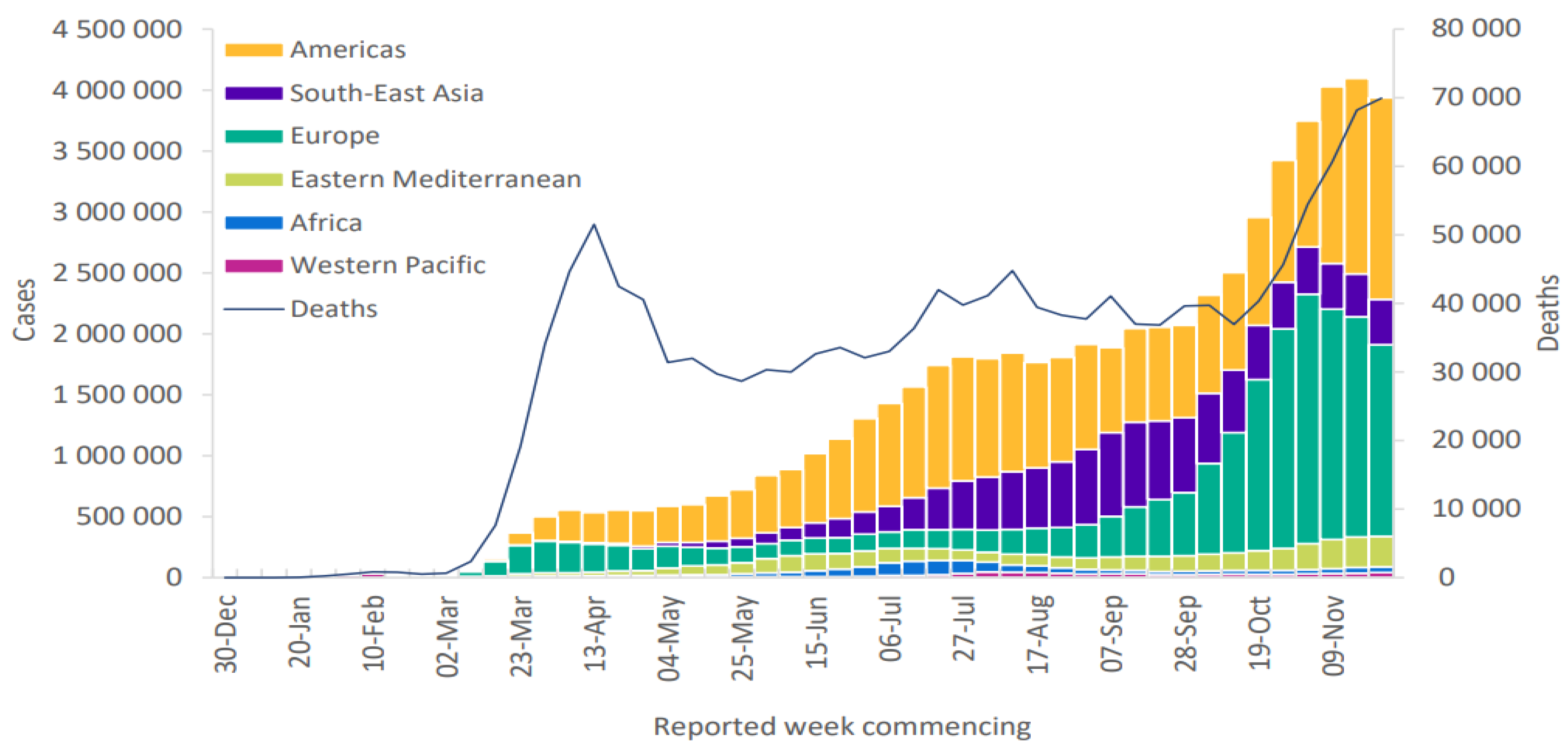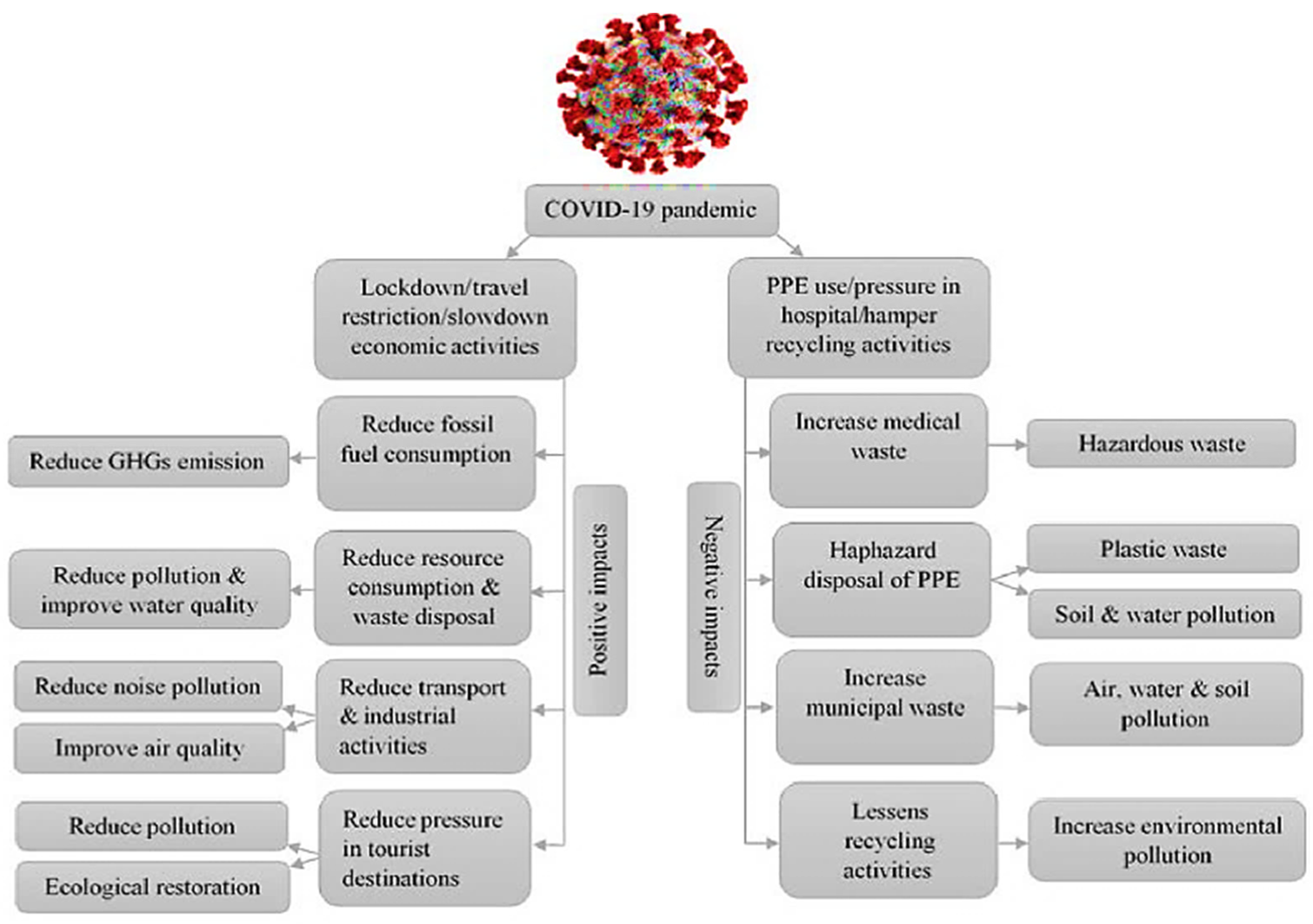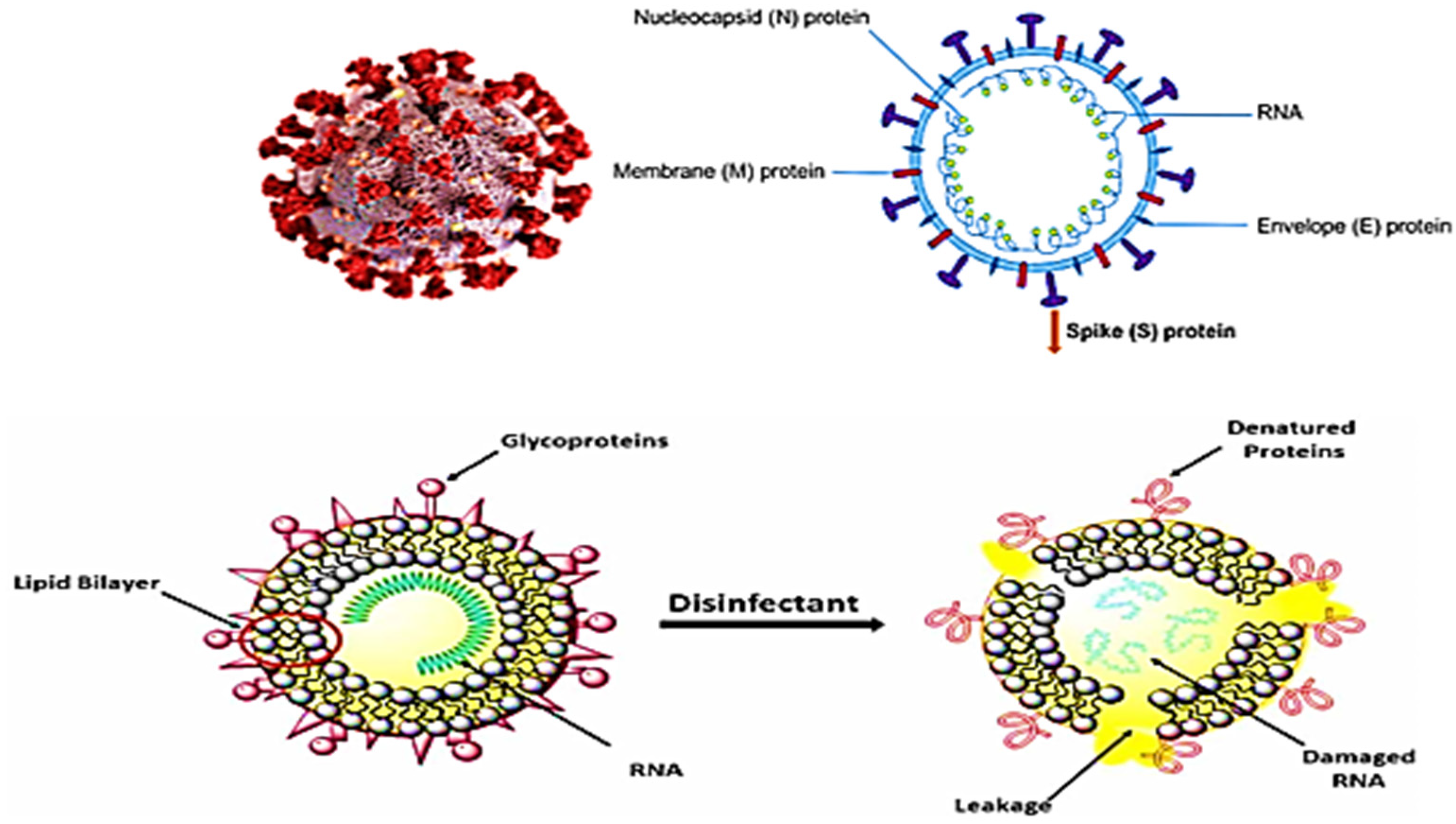Coronavirus (COVID-19): What Could Be the Environmental Effects of Disinfectant Use in the Pandemic? †
Abstract
:1. Introduction
2. Conclusions
- First, public health and environmental safety should be considered when deciding on when, where, and how disinfection should be carried out and which disinfectant to use. For example, rather than indiscriminate spraying of high volumes of disinfectants in biodiversity-rich areas such as urban parks, wetlands, and green spaces, it may be preferable to suspend human activities in such places.
- Second, as information on the ecological consequences of excessive application of disinfectants in cities is limited, further research on the potential threats of these practices to the environment and to biodiversity is urgently needed.
- Third, disinfectants should be developed as soon as possible which are low-risk, non-toxic, intervenable within a sudden and unexpected situation, and suitable for common application in open urban environments.
- Fourth, antibacterial products (soap, wipes, gels etc.) should not be preferred, especially in hand disinfectants. Because these products cause the death of beneficial bacteria in the human skin, the immune system of the individuals may be adversely affected.
Author Contributions
Funding
Conflicts of Interest
References
- Hui, D.S.; Azhar, E.I.; Madani, T.A.; Ntoumi, F.; Kock, R.; Dar, O.; Ippolito, G.; Mchugh, T.D.; Memish, Z.A.; Drosten, C.; et al. The continuing 2019-nCoV epidemic threat of novel coronaviruses to global health-The latest 2019 novel coronavirus outbreak in Wuhan, China. Int. J. Infect. Dis. 2020, 91, 264–266. [Google Scholar] [CrossRef] [PubMed] [Green Version]
- World Health Organization. WHO Characterizes COVID-19 as a Pandemic. 2020. Available online: https://www.who.int/emergencies/diseases/novel-coronavirus-2019/events-as-they-happen (accessed on 27 October 2020).
- Biswaranjan, P. Nurture to nature via COVID-19, a self-regenerating environmental strategy of environment in global context. Sci. Total Environ. 2020, 729, 139088. [Google Scholar]
- Tanjena, R.S.M.; Didar-Ul, I. Environmental effects of COVID-19 pandemic and potential strategies of sustainability. Heliyon 2020, 6, e04965. [Google Scholar]
- Hiscott, J.; Alexandridi, M.; Muscolini, M.; Tassone, E.; Palermo, E.; Soultsioti, M.; Zevini, A. The global impact of the coronavirus pandemic. Cytokine Growth Factor Rev. 2020, 53, 1–9. [Google Scholar] [CrossRef]
- Nagendra Kumar, R.; Anushruti, A.; Butchi, R.A. Consequences of chemical impact of disinfectants: Safe preventive measures against COVID-19. Crit. Rev. Toxicol. 2020, 50, 513–520. [Google Scholar]
- Zheng, G.; Filippelli, G.M.; Salamova, A. Increased indoor exposure to commonly used disinfectants during the COVID-19 pandemic. Environ. Sci. Technol. Lett. 2020, 7, 760–765. [Google Scholar] [CrossRef]
- Dumas, O.; Varraso, R.; Boggs, K.M.; Quinot, C.; Zock, J.P.; Henneberger, P.K.; Speizer, F.E.; Le Moual, N.; Camargo, C.A. Association of occupational exposure to disinfectants with incidence of chronic obstructive pulmonary disease among US female nurses. JAMA Netw. Open 2019, 2, e1913563. [Google Scholar] [CrossRef] [PubMed]
- Hora, P.I.; Pati, S.G.; McNamara, P.J.; Arnold, W.A. Increased use of quaternary ammonium compounds during the SARS-CoV-2 pandemic and beyond: Consideration of environmental implications. Environ. Sci. Technol. Lett. 2020, 7, 622–631. [Google Scholar] [CrossRef]
- Li, D.; Sangion, A.; Li, L. Evaluating consumer exposure to disinfecting chemicals against coronavirus disease 2019 (COVID-19) and associated health risks. Environ. Int. 2020, 145, 106108. [Google Scholar] [CrossRef]
- Mohammad Hussein, A.S. Chemical disinfectants of COVID-19: An overview. J. Water Health 2020, 18, 843–848. [Google Scholar]
- Kampf, G.; Todt, D.; Pfaender, S.; Steinmann, E. Persistence of coronaviruses on inanimate surfaces and its inactivation with biocidal agents. J. Hosp. Infect. 2020, 104, 246–251. [Google Scholar] [CrossRef] [PubMed] [Green Version]
- EPA. List N: Disinfectants for Use against SARS-CoV-2 (COVID-19). 2020. Available online: https://www.epa.gov/pesticide-registration/list-n-disinfectants-useagainst-sars-cov-2-covid-19 (accessed on 27 October 2020).
- Roy, A.; Parida, S.P.; Bhatia, V. Role of disinfection and hand hygiene: A COVID-19 perspective. Int. J. Community Med. Public Health 2020, 7, 2845–2849. [Google Scholar] [CrossRef]
- Qianyu, L.; Jason, Y.C.L.; Kun, X.; Pek, Y.M.Y.; Cally, O.; Pei, L.C.; Xian, J.L. Sanitizing agents for virus inactivation and disinfection. View 2020, 1, e16. [Google Scholar]
- Daeed, Y.; Hanns, M.; Ayda, F.A.; Alireza, M.J. Side effects of using disinfectants to fight coronavirus. Asian Pac. J. Environ. Cancer 2020, 3, 9–13. [Google Scholar]
- Sadia, I.; Tajiv, R.S.; Hyunjung, K. Disinfection technology and strategies for COVID-19 hospital and bio-medical waste management. Sci. Total Environ. 2020, 749, 141652. [Google Scholar]
- You, T. More than 100 Wild Animals Drop Dead near Coronavirus Epicentre in China after Workers ‘Sprayed Too Much Disinfectant’ to Prevent Coronavirus. 2020. Available online: https://www.dailymail.co.uk/news/article-8029271/100-wild-animals-drop-dead-near-coronavirus-epicentre.html (accessed on 27 October 2020).
- El-Nahhal, I.; El-Nahhal, Y. Ecological consequences of COVID-19 outbreak. J. Water Sci. Eng. 2020, 1, 1–5. [Google Scholar]
- Zhang, S.; Wang, C.; Lin, M.; Deng, Q.; Ye, Y.; Li, Z.; Qiu, L.; Wang, Z. Analysis of the virus contamination and disinfection effect in isolation ward of patients with COVID-19. Front. Public Health 2020, 8, 486. [Google Scholar] [CrossRef] [PubMed]
- Zhang, H.; Tang, W.; Chen, Y.; Yin, W. Disinfection threatens aquatic ecosystems. Science 2020, 368, 146–147. [Google Scholar] [CrossRef] [PubMed] [Green Version]
- Sepp, T.; Ujvari, B.; Ewald, P.W.; Thomas, F.; Giraudeau, M. Urban environment and cancer in wildlife: Available evidence and future research avenues. Proc. Biol. Sci. 2019, 286, 20182434. [Google Scholar] [CrossRef] [PubMed] [Green Version]
- Jane, L.J.J.; Thong, P.Y.; Rajendran, J.C.B.; Jason, R.M.; Nagendran, T.; Thiagarajan, M. Hand sanitizers: A review on formulation aspects, adverse effects, and regulations. Int. J. Environ. Res. Public Health 2020, 17, 3326. [Google Scholar]
- Hadis, F.; Parham, M.; Mansooreh, M.-H.; Sounkalo, D.; Sükran, K.; Khudaverdi, G.; Pasquale, P.; Silvano, E.; Hossein, S.K. Protection and disinfection policies against SARS-CoV-2 (COVID-19). Le Infez. Med. 2020, 2, 185–191. [Google Scholar]
- Mackenzie, J.S.; Jeggo, M. The one health approach-why is it so important? Trop. Med. Infect. Dis. 2019, 4, 88. [Google Scholar] [CrossRef] [PubMed] [Green Version]




| Ingredients | Effective Contact Time (min) |
|---|---|
| Quats | 10 |
| Hydrogen peroxide | 10 |
| Isopropanol | 0.5 |
| Sodium hypochlorite | 10 |
| Octanoic acid | 2 |
| Phenolic | 10 |
| Ethanol | 2 |
| Triethylene glycol | 5 |
| l-lactic acid | 10 |
| Peroxyacetic acid | 1 |
| Glycolic acid | 10 |
| Citric acid | 1 |
| Hypochlorous acid | 10 |
| Ammonium carbonate | 6 |
Publisher’s Note: MDPI stays neutral with regard to jurisdictional claims in published maps and institutional affiliations. |
© 2021 by the authors. Licensee MDPI, Basel, Switzerland. This article is an open access article distributed under the terms and conditions of the Creative Commons Attribution (CC BY) license (https://creativecommons.org/licenses/by/4.0/).
Share and Cite
Çelebi, H.; Bahadır, T.; Şimşek, İ.; Tulun, Ş. Coronavirus (COVID-19): What Could Be the Environmental Effects of Disinfectant Use in the Pandemic? Med. Sci. Forum 2021, 4, 27. https://doi.org/10.3390/ECERPH-3-08981
Çelebi H, Bahadır T, Şimşek İ, Tulun Ş. Coronavirus (COVID-19): What Could Be the Environmental Effects of Disinfectant Use in the Pandemic? Medical Sciences Forum. 2021; 4(1):27. https://doi.org/10.3390/ECERPH-3-08981
Chicago/Turabian StyleÇelebi, Hakan, Tolga Bahadır, İsmail Şimşek, and Şevket Tulun. 2021. "Coronavirus (COVID-19): What Could Be the Environmental Effects of Disinfectant Use in the Pandemic?" Medical Sciences Forum 4, no. 1: 27. https://doi.org/10.3390/ECERPH-3-08981
APA StyleÇelebi, H., Bahadır, T., Şimşek, İ., & Tulun, Ş. (2021). Coronavirus (COVID-19): What Could Be the Environmental Effects of Disinfectant Use in the Pandemic? Medical Sciences Forum, 4(1), 27. https://doi.org/10.3390/ECERPH-3-08981






